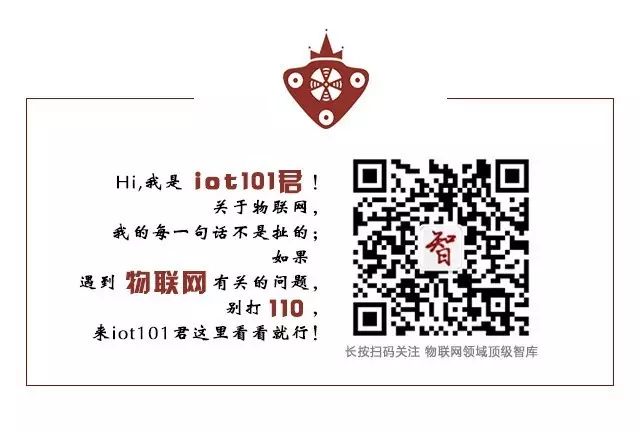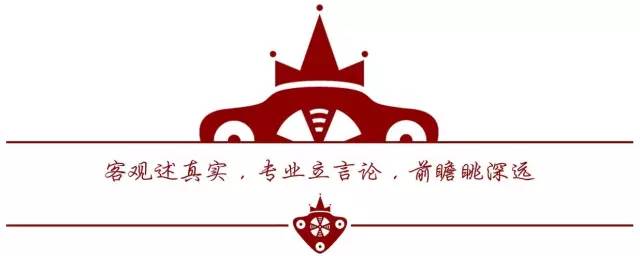
Source: China Mobile OneNET (ID: CMCC-OneNET)
Organized and published by the IoT Think Tank
Please indicate the source and origin when reprinting
—— [Introduction] ——
This article proposes some low power design methodologies for IoT terminals based on the low power requirements of the IoT and certain business scenarios, and lists application scenarios and corresponding solutions.
Low Power Design Methodology for IoT Terminal Products
(Summary)
▊Background Overview
Recently, IoT LPWA (Low Power Wide Area Network) technology has received significant attention and has been actively deployed globally. Currently, LPWA is the most suitable network technology for the low power needs of the IoT, but the industrial chain development is still immature. For example, NB-IoT faces issues such as high costs and insufficient coverage.
This article proposes some low power design methodologies for IoT terminals based on the low power requirements of the IoT and certain business scenarios, and lists application scenarios and corresponding solutions.
▊Overview of Low Power Application Scenarios and Methodologies
▶ 1. LPWA Low Power Implementation
LPWA is a network technology specifically designed for IoT application scenarios, with low power design implemented from the dimensions of terminal power consumption, network parameters, and data transmission protocols.
Taking NB-IoT as an example, its main low power implementation methods involve two key technologies: PSM (Power Saving Mode) and eDRX (Extended Discontinuous Reception). The power consumption when the device is in PSM mode is very low, and NB-IoT keeps the device in PSM mode for long periods. On the other hand, the eDRX technology used by NB-IoT increases the sleep cycle of the device during idle states, further reducing overall power consumption.
It can be seen that the most effective way to achieve low power technology currently is to minimize power consumption when the terminal is not performing data interactions.
▶ 2. Several Low Power Business Models and Scenario Applications
According to the analysis above, the main low power implementation technologies of LPWA are very suitable for business scenarios with low frequency of data transmission and low throughput. Based on the data transmission cycle classification, several basic business models for such low power scenarios are established:
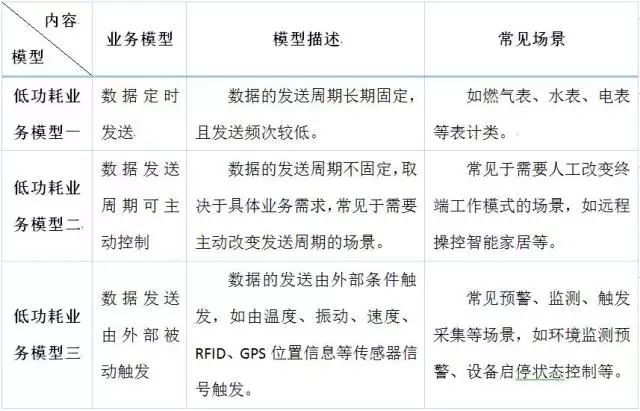
Several Common Low Power Business Models
It should be noted that the above three are independent business models derived from common low power scenarios, and in many cases, they are composite scenarios of the three models.
For the above three business models, actual scenarios are listed, providing solutions represented by NB-IoT as LPWA, as well as low power technology architecture for terminals designed based on traditional cellular networks, and a comparative analysis of the two technologies from the perspective of power consumption.
(1) Business Model One Scenario: Gas Meter Reading
Business Requirement: Meter data transmission cycle is 24 hours, data packet size is 50 Bytes
● LPWA Solution: Use NB-IoT network. Set the TAU (Tracking Area Update) cycle to 24 hours as the business data uplink cycle; configure the PSM active timer and RRC link release timer according to the specific business model;
● Traditional Cellular Terminal Solution: 2G-eSIM module (eSIM is a chip and module product independently developed by China Mobile IoT Co., Ltd., which directly integrates the SIM card function of the mobile company and supports 2G/3G/4G and 5G/NB-IoT, automatically connecting to China Mobile IoT’s device cloud OneNET) + RTC (Real-Time Control Unit) solution.
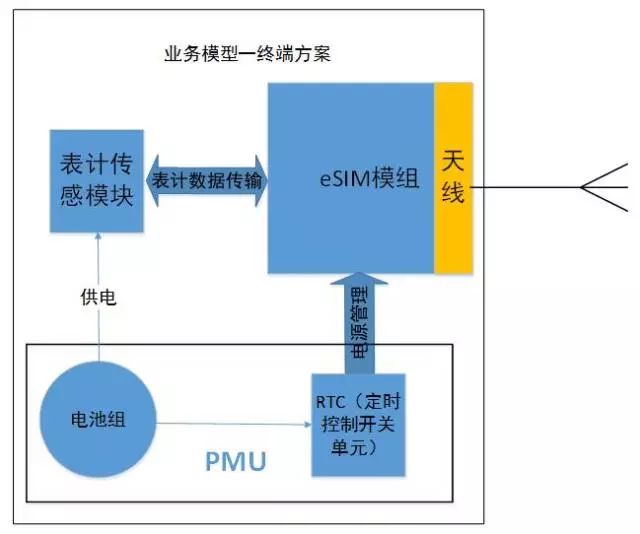
Business Model One: eSIM Module + RTC (Fixed Cycle) Solution
(2) Business Model Two Scenario: Logistics Pallet Positioning (detailed solution see [Read the Original])
(3) Business Model Three Scenario: Agricultural Greenhouse Environment Monitoring (detailed solution see [Read the Original])
(4) Power Consumption Comparison of Each Business Model
Comparing the power consumption of the two solutions under each business model, other influencing factors are not considered here (assuming the network signal strength compared is the same). The data is sourced from the China Mobile Communications Research Institute and China Mobile IoT Co., Ltd.
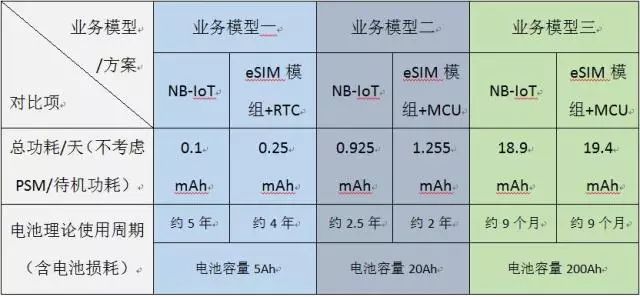
Power Consumption Comparison of Two Solutions Under Each Business Model
The comparison results indicate that in the three low power business scenarios, the solutions optimized by some low power technology architectures based on traditional cellular networks have power consumption that is not much different from the NB-IoT solution, and the two are basically comparable.
▶ 3. Low Power Design Methodology for IoT Terminals
To ultimately provide customers with suitable low power overall solutions, the key ideas of the low power design methodology for terminals are summarized, and should be comprehensively considered and implemented from the following aspects:
(1) Based on the data transmission cycle and data volume requirements of specific business scenarios, determine the terminal working mode, adopt appropriate communication technology, and choose a reasonable data transmission cycle control method, which is to minimize power consumption when the terminal is not performing data interactions, maximizing power savings. Taking the low power 2G technology and NB-IoT technology introduced in this article as examples, a simple reference matrix comparison can be made for the selection of communication technology from the perspective of power consumption.
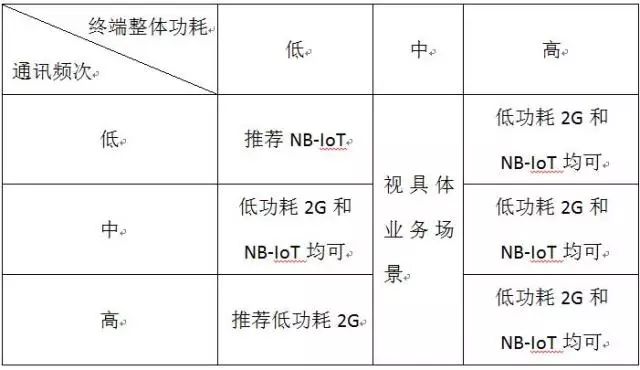
Scenario Requirements and Terminal Communication Mode Adaptation Matrix
(2) In satisfying low power solutions, comprehensively compare the costs of the solutions, including terminal costs, network deployment costs, development costs, and later maintenance costs;
(3) Consider and compare other factors, such as reliability, security, coverage, etc.
▊Low Power Application Scenarios and Solution Examples
Scenario Requirement: Position monitoring of containers in a certain international railway transport project during transportation. The position transmission cycle during train travel is 2 hours, and the position transmission cycle during train stops is 1 day, with position accuracy less than 200m.
Based on business model analysis and terminal low power design methodology, a comparative solution is provided based on traditional cellular network terminals and NB-IoT. (Detailed solution see [Read the Original])
▶ 1. Power Consumption Comparison
Based on the above testing and calculation data analysis, a comparison of power consumption indicators for the solutions based on 2G cellular technology and NB-IoT is made, with the comparison shown in Table 2.
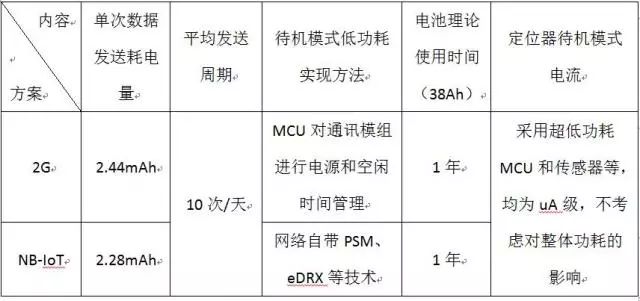
Power Consumption Comparison of Two Solutions
In summary, without considering costs, reliability, and other factors, only comparing and analyzing terminal power consumption, the terminal solution based on 2G and optimized with low power design architecture, compared to the theoretical indicators of the NB-IoT solution, has comparable power consumption.
▶ 2. Cost Comparison
Next, a comparison of the terminal costs of the two solutions is made, with a demand for 10,000 sets of locators, and the main cost items are shown in Table 3. Since the main difference between the two terminal solutions is the communication modules, the hardware costs of the locators only consider the module and battery costs.
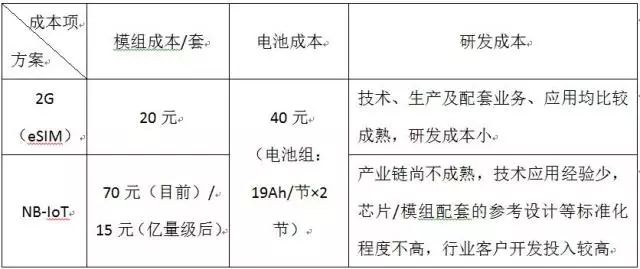
Cost Comparison Analysis of 2G and NB-IoT Solutions
▶ 3. Consideration of Other Factors
From the perspective of signal coverage, the mobile area of the railway transportation scenario is very vast, and the current network coverage rate of NB-IoT cannot even meet the coverage breadth requirements.
▶ 4. Final Solution Selection
The terminal power consumption of the two solutions is basically comparable, and under the premise of meeting the same working lifespan (1 year), the battery costs consumed are the same; however, due to lower costs for 2G modules, research and development, etc., the comprehensive calculation shows that the cost of the 2G solution is approximately 45% lower than that of the NB-IoT solution, and the final choice is to provide the 2G solution to users.
▊Conclusion
This article provides the low power design methodology for IoT terminals. An important issue for the IoT is solving low power consumption under massive connectivity; in fact, power consumption optimization is a complex, gradual accumulation process that requires comprehensive consideration from various aspects, including the terminal itself, business models, network parameters, costs, reliability, and more, to provide an overall solution.

Previous Hot Articles (Click the article title to read directly):
-
“How Difficult is it to Make Smart Locks on Shared Bicycles?”
-
“Cognitive Computing, Blockchain IoT, IoT Security… Those Who Understand Will Control the Future”
-
“KUKA, ABB, FANUC, Yaskawa, Four Major Industrial Robot Giants Have Long Been Stationed in the IoT Field”
-
“[Heavyweight] IoT Industry Panorama Report, The First Domestic IoT Industry Two-Dimensional Perspective Panorama”
-
“A Comic Tells You: Besides WiFi and Bluetooth, What Can the Recently Popular NB-IoT Do?”
-
“A Comic Tells You: What is LoRa, Which Everyone is Talking About Behind NB-IoT?”
